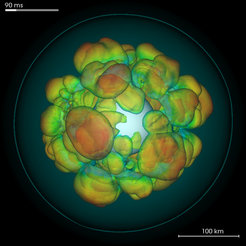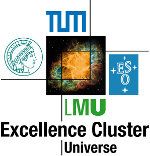Core-collapse supernovae

Core-collapse supernovae are dramatic explosions of giant stars at the end of their thermonuclear evolution giving birth to neutron stars and black holes. They are among the most energetic phenomena in the universe, play a key role in the formation and spreading of the chemical elements, trigger the formation of new stars, and are closely related to a sub-class of the enigmatic gamma-ray bursts. Hence, astro-physicists have a strong interest to understand which stars do explode as supernovae, which physical processes cause the explosion, and which are the observable consequences of these cataclysmic events.
The optical supernova outburst commences when the explosion wave, generated in the optically obscured stellar center, eventually reaches the surface layers of the star. As giant stars have very large radii, the optical outburst begins only hours after the actual onset of the catastrophe in the very center of the star. There the burnt out stellar iron core collapses due to electron captures and photo-disintegration of heavy nuclei to a neutron star or black hole thereby liberating the energy which causes the supernova explosion.
The only means to get direct and immediate information about the supernova "engine" is from observations of neutrinos emitted by the forming neutron star, and through gravitational waves which are emitted when the collapse does not proceed perfectly symmetrically because of rotation, violent turbulent mass motions, and anisotropic neutrino emission. Numerical simulations exploiting the most powerful supercomputers provide a third way to study the complex supernova phenomenon. However, this poses a true challenge as they require multidimensional neutrino radiation hydrodynamics, a detailed treatment of weak interaction processes and neutrino matter coupling, the handling of vastly different length and time scales, in particular when simulating shock propagation through the envelope of the progenitor star, and possibly the incorporation of effects due to rotation and magnetic fields.
The Core-Collapse Supernova group at MPA led by Hans-Thomas Janka has been awarded a European Research Council Advanced Grant. More information about ongoing research and recent results can be found on the project page:

Modeling Stellar Collapse and Explosion: Evolving Progenitor Stars to Supernova Remnants
In order to allow for an easy data exchange with collaborators who want to use the simulation results of the Garching group for their own research, a regularly updated data archive is provided. Data and movies of supernova simulations can be found here:
The Garching Core-Collapse Supernova Archive
Funding sources
EXC 153: Origin and Structure of the Universe - The Cluster of Excellence for Fundamental Physics
European Research Council Advanced Grant







